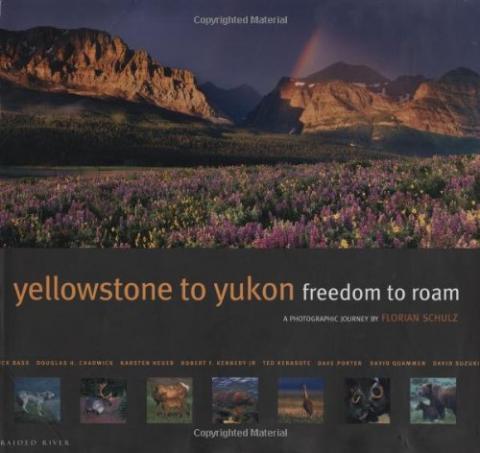What's the price of wilderness? What is the value of wildlife, thick forests, clean rivers and craggy alpine vistas uncluttered by development? We struggle with those questions daily, and the answers are at times hard to accurately summon or garner consensus.
The questions and answers become even more complicated when you look at a place like Yellowstone National Park and come to appreciate the problems humans created for wildlife by largely relying upon political boundaries to create the park. While those boundaries neatly package the park and most of its wonders, they fail wildlife that need room to roam and exchange their genes.
In Yellowstone to Yukon: Freedom to Roam ($34.95), a new 195-page book from The Mountaineers Books, a collection of 200 pictures and essays from such notable nature writers as David Quammen, Rick Bass and Douglas Chadwick strives to lend context to the proposal to create a wildlife corridor from Yellowstone all the way north to the Yukon.
The photos, of wildlife, landscapes, even industry at work in this landscape, are the work of Florian Schulz, a German whose boyhood dreams of someday visiting places like the Rock Mountain West were stoked by the marvelous works of Jack London. For ten years Schulz worked on this project, hoping to capture on film images that would inspire conservation.
"Why would a photographer from Germany spend ten years photographing the Rocky Mountains of North America? There are beautiful mountains in Europe, as well as ancient castles, medieval towns, and ruins that date back millennia," he says. "The answer is that we have nothing in Europe that matches the sheer size and scope of the Yellowstone to Yukon area, with its wide-open landscapes and incredible array of wildlife.
"Most significantly," he adds, "we don't have true wilderness. We have lost our wild lands."
Today in North America we are teetering on the brink of losing our wild lands. Some might scoff at that notion, but if you look at the urban sprawl that is creeping up to places like Yosemite, Zion, Great Smoky Mountains and other national parks you can see it happening.
While "urban" sprawl doesn't afflict Yellowstone, logging, energy development, and the spread of ranchettes have combined to spring up like prison walls to the park's wildlife. All one need do is look at the plight of Yellowstone's bison herds to see how development is impinging on wildlife.
Schulz does find wilderness through his camera lens. But we must ask ourselves how fleeting is it? Do we as a society have the courage and determination to create something as grand, sprawling and wildly ambitious as the Yellowstone-to-Yukon corridor, a 2,200-mile-long swath of wilderness that, in theory at least, would enable bison, wolves, grizzlies, wolverines, bighorn sheep, mountain goats and other animals to wander, migrate and swap genes much as they naturally would?
Running from Wyoming's Wind River Range, through Yellowstone and on north through Idaho, Montana and British Columbia en route to the Yukon, the Y2Y is an audacious proposal.
Along its route the corridor would link such places as the National Elk Refuge in Wyoming, Red Rock Lakes National Wildlife Refuge in Idaho, the Great Bear and Bob Marshall wilderness areas in Montana, with places such as the Purcell Wilderness Conservancy Provincial Park in British Columbia, Willmore Wilderness Provincial Park in Alberta, the Muskwa-Kechika Management Area in British Columbia and the Nisutlin River Delta National Wildlife Area in the Yukon.
In the book's accompanying essays, the threats to that vision are expressed, the solutions identified, and the writers challenge us to get behind Y2K.
""Human activity and demand are extending into the furthest reaches of the globe through logging, mining, dams, clearing for agriculture, and urban sprawl," writes David Suzuki, a geneticist, author and "environmental thinker." "Can human activity take place while protecting the necessary space and complexity that wild organisms need to flourish? That's the promise of the Y2K vision."
To Douglas Chadwick, educated as a biologist and now a wonderful writer, the Y2Y mission is too valuable to let slip away.
"Both a practical strategy and a unifying vision, Y2K may be thought of as a blueprint for bringing the forces of culture, economics, and ecology into balance," he says. "This seems like the most sensible goal in the world. Since it also seems among the hardest to achieve, maybe a better definition of Y2Y is: a much needed experiment in the grandest of laboratories."
Yellowstone to Yukon: Freedom to Roam is a beautiful, inspiring book. The size of a coffee-table book, it should be displayed to encourage you and your friends to return to its messages often. Hopefully it won't be used years from now as somewhat of a history book to show us what once was.








Comments